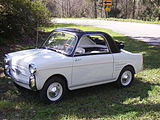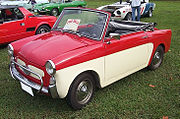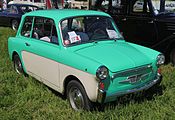
Autobianchi was an Italian automobile manufacturer, created jointly by Bianchi, Pirelli and Fiat in 1955. Autobianchi produced only a handful of models during its lifetime, which were almost exclusively small cars, with the biggest being the short-lived Autobianchi A111, a small family car. Autobianchis were priced higher than Fiat models of similar size and the brand was used by Fiat to test innovative concepts which later found their way into mainstream Fiat vehicles; these concepts included fibreglass bodies and front-wheel drive.

The Fiat 500 is an economy / city car that was manufactured and marketed by Fiat Automobiles from 1957 until 1975. It was sold as a two-door semi-convertible or saloon car and as a three-door panel van or estate car.

The Fiat 500, commonly known as "Topolino", is an Italian city car produced and manufactured by Fiat from 1936 to 1955.

The Fiat 1100 is a small family car produced from 1953 until 1969 by the Italian manufacturer Fiat. It was an all-new unibody replacement for the Fiat 1100 E, which descended from the pre-war, body-on-frame Fiat 508 C Balilla 1100. The 1100 was changed steadily and gradually until being replaced by the new Fiat 128 in 1969. There were also a series of light commercial versions of the 1100 built, with later models called the Fiat 1100T, which remained in production until 1971. The Fiat 1100 D also found a long life in India, where Premier Automobiles continued to build the car until the end of 2000.

The Lancia Beta was an entry-level luxury car produced by Italian car manufacturer Lancia from 1972 to 1984. It was the first new model introduced by Lancia after it had been taken over by Fiat in 1969.
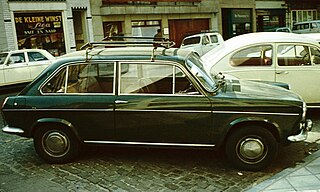
The Autobianchi Primula is a supermini economy car manufactured between 1964 and 1970 by the Italian automaker Autobianchi, partly owned by and later a subsidiary of the Fiat Group. The Primula was a prototype for Fiat's rack and pinion steering and is widely known for its innovative Dante Giacosa-designed front-wheel drive, transverse engine layout — that would be later popularized by the Fiat 128 to ultimately become an industry-standard front drive layout.

The Autobianchi A112 is a supermini produced by the Italian automaker Autobianchi. It was developed using a shrunken version of the contemporary Fiat 128's platform. The mechanicals of the A112 subsequently underpinned the Fiat 127. It was introduced in November 1969, as a replacement for the Bianchina and Primula, and was built until 1986, when it made way for the more modern Autobianchi Y10. Over 1.2 million A112s were produced in Autobianchi's Milan factory.

The Alfa Romeo 1900 is an automobile produced by Italian car manufacturer Alfa Romeo from 1950 until 1959. Designed by Orazio Satta, it was an important development for Alfa Romeo as the marque's first car built entirely on a production line and first production car without a separate chassis. It was also the first Alfa Romeo offered with left-hand drive. The car was introduced at the 1950 Paris Motor Show.

The Lancia Gamma is an executive car manufactured and marketed by the Lancia subdivision of Fiat. Following its debut at the 1976 Geneva Motor Show as Lancia's new flagship, the Gamma was marketed as 4-door fastback saloon as the Berlina (1976-1984) and as 2-door coupé (1977-1984), both designed by Pininfarina — with 15,272 and 6,790 manufactured, respectively. The Gamma superseded the Lancia Flavia.

Dante Giacosa was an Italian automobile designer and engineer responsible for a range of Italian automobile designs — and for refining the front-wheel drive layout to an industry-standard configuration.

The Fiat 1300 and Fiat 1500 are a series of front-engine, rear-drive automobiles manufactured and marketed by Fiat from 1961 to 1967, replacing the Fiat 1400 and Fiat 1200 coupé, spyder and cabriolet. The 1300 and 1500 were essentially identical to each other except for their engine displacement, as indicated by their model names, and were offered in sedan/saloon, station wagon, convertible and coupé body styles which shared little mechanically with the other body styles except the 1500 engine.

The Fiat 1400 and Fiat 1900 are passenger cars produced by Italian automotive manufacturer Fiat from 1950 to 1958 and from 1952 to 1959 respectively. The two models shared body and platform, but while the 1.4-litre 1400 was Fiat's intermediate offering, the upmarket 1900 had an enlarged 1.9-litre engine and more luxurious trim and equipment, to serve as flagship in the manufacturer's range.

The Fiat 518, also called Fiat Ardita, was a model of car produced by Italian car manufacturer Fiat between 1933 and 1938. The name "Ardita" was also used on the six-cylinder engined and more expensive Fiat Ardita 2500 or 527.
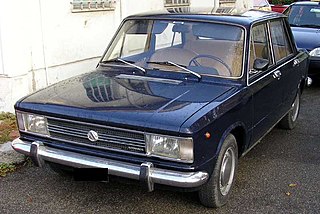
The Autobianchi A111 is a 4-door saloon family car produced from 1969 to 1972 by Italian car manufacturer Autobianchi, a subsidiary of the Fiat group. Despite rather modest dimensions, at roughly 4 metres long, it was the largest Autobianchi ever made, as the brand specialized in small cars. A modern front-wheel drive construction like the Fiat 128 launched concurrently, it was based on the revolutionary Autobianchi Primula, Fiat's first "experiment" with the transverse engine front-wheel-drive setup.

The Lancia Artena is a passenger car produced by Italian car manufacturer Lancia from 1931 until 1936, and from 1940 until 1942 chiefly for army and government use. It was powered by a 2-litre Lancia V4 engine, while chassis and factory bodies were shared with the more luxurious 2.6-litre V8-engined Lancia Astura. Total production amounted to 5,567 examples.

Fiat 1200 was the name of three distinct models produced by Italian car manufacturer Fiat, all based on Fiat 1100 mechanicals. The first two were introduced in 1957, and replaced the TV variants at the top of the Fiat 1100 range: the 1200 Granluce, an upmarket small four-door saloon derived from the 1100, and the 1200 Spyder, an update of the previous 1100 TV Trasformabile 2-door roadster. The 1200 Granluce was discontinued in 1961 when larger Fiat saloons were introduced, while the 1200 Trasformabile/Spyder was replaced in 1959 by the 1200 Cabriolet. This was a new Pininfarina design, later developed into the 1200 and 1500 Cabriolets.

The Autobianchi Giardiniera is a supermini produced by the Italian automaker Autobianchi, based on the Fiat 500 Giardiniera. The Fiat version being offered since 1960. It was available in various configurations: station wagon and van. Car was produced from 1968 to 1977 effectively replacing the Fiat counterpart. It was also marketed as the Autobianchi Bianchina Giardiniera. The overall layout was very similar to the earlier Panoramica but the Giardiniera was more utilitarian oriented and ideally suited for light commerce. It also retained the same exterior design from Fiat with only a badge change, and still featured the suicide doors.

The Volkswagen T-Roc is a subcompact crossover SUV (B-segment) manufactured by German automaker Volkswagen. It was unveiled at the 2017 Frankfurt Motor Show, and launched in November 2017. It is based on the Volkswagen Group MQB A1 platform, and generally has been considered as the SUV equivalent of the C-segment Golf. It is positioned between the Tiguan and the slightly smaller T-Cross, while being approximately the same size as the Taigo.

The Fiat 1100 is a small family car produced from 1937 to 1953 by the Italian car manufacturer Fiat. It was introduced in 1937 as Fiat 508 C or Balilla 1100, as a replacement for the Fiat 508 Balilla. Under the new body the 508 C had more modern and refined mechanicals compared to the 508, including independent front suspension and an enlarged overhead valve engine. In 1939 it was updated and renamed simply Fiat 1100. The 1100 was produced in three consecutive series—1100, 1100 B and 1100 E—until 1953, when it was replaced by the all-new, unibody Fiat 1100/103.

The Fiat Pininfarina Cabriolet was a two-door, two passenger, front engine rear drive convertible, with 145R14 Pirelli Cinturato tyres manufactured by Pininfarina, and marketed by Fiat across two generations, superseding the Fiat 1200 Spider.

